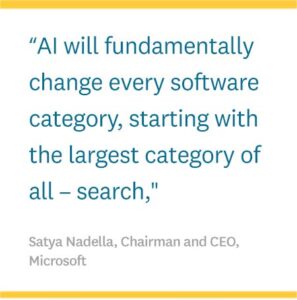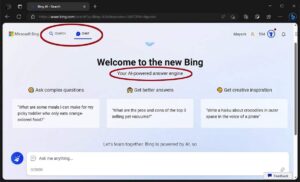 Rethinking Search Mental Models
Rethinking Search Mental Models
In a digital age saturated with data, enhancing searching capabilities to provide quick, accurate, and relevant results is of paramount importance. However current search methods, while highly evolved, still leave room for improvement. Can chat-based language models offer the much-needed enhancement? The new Microsoft Bing answer engine suggests that this might be the way forward.
Here’s What I’m Thinking: Yes… Let’s Up Our Search Game!
The Problem of Keyword-Based Searches: A Lack of Precision and Context
Keyword-based searches, for all their usefulness, have inherent limitations that often lead to less than satisfactory results. The main issue lies in their inability to fully grasp the nuance and context of user queries.
 1. Imprecision of Keywords
1. Imprecision of Keywords
Users generally input search terms or phrases—“keywords”—into a search engine, which then matches these keywords with its database to provide relevant results. However, the precision of these results depends heavily on the accuracy of the keywords used. Given that language is rife with ambiguity, synonyms, and cultural nuances, keyword searches can, at times, be inefficient or misleading.
2. Context Matters
For instance, consider a user searching for “java.” The word could refer to the island in Indonesia, a type of coffee, or the popular programming language. A keyword search doesn’t inherently distinguish between these meanings, which can result in an overwhelming range of search results, many of which could be irrelevant.
Moreover, keyword-based searches sometimes miss the intent behind the search. If a user types “How to bake a chocolate cake?” into a search engine, they are not interested in the ‘chocolate cake’ itself, but rather the process of ‘baking’ it. Traditional keyword algorithms lack the semantic understanding to differentiate between such nuances, leading to both relevant and completely unrelated results.
3. Overcoming the Overload of Results
Coupled with this is the issue that users often have to sift through multiple pages of search results to find what they need. The reams of information returned by a keyword source can be overwhelming and time-consuming to navigate. For users in need of quick and accurate responses, this process can be quite cumbersome.
4. Pioneering the Future of Search
Thus, while keyword-based searches have undeniably revolutionized the way we find information, their limitations underscore the need for more intelligent search mechanisms. The integration of AI and chat-based language models appears to be a compelling solution, offering a greater understanding of context, nuance, and user intent, all aimed at providing more accurate and intended search results faster.
The Solution: Combining AI-Powered Chatbots + Search Engines
While traditional search engines were evolving, another technology was gaining traction: AI-powered chatbots. These are machine learning algorithms designed to simulate human conversation, and they’re often used in customer service to handle routine queries. These chatbots operate on NLP models, understanding and responding to the user’s intent.

Microsoft’s Bing’s “AI-Powered Answer Engine”
The Introduction of Microsoft’s Bing AI-Powered “Answer Engine” is a Game-Changing
Microsoft Bing has taken a significant stride toward building a more intelligent, responsive, and personalized search experience with its AI-powered “Answer Engine.” It represents a paradigm shift from tradition to innovation by combining algorithmic mastery with the power of machine learning and artificial intelligence.
Redefining Search Parameters: The Bing “Answer Engine”
The Bing “Answer Engine” is designed to go beyond conventional search parameters. Unlike typical search engines that simply return lists of links that may hold the answer, Bing’s “Answer Engine” aims to provide direct, concise answers to search queries.
Harnessing Advanced Tech: The Sophisticated AI at the Core of Bing’s Answer Engine
At the core of the Answer Engine is a sophisticated AI model that leverages advanced machine learning algorithms and natural language processing capabilities. This foundation empowers Bing to understand and interpret the complex nuances and contexts inherent in human language, allowing the Answer Engine to decipher not just what users are asking for, but also why they’re asking for it.
Learning and Evolving: The Constant Adaption of Bing’s AI Model
The AI model also engages in constant learning. It takes into account the behavior and reaction of users to the search results provided, improving and refining itself based on that usage data. Consequently, over time it becomes more adept at predicting user search behavior and delivering results that match search intent quickly and accurately.
Forging Interactive Experiences: The User-Engaging Drive of Bing’s Answer Engine
Moreover, the Answer Engine represents the drive toward a more interactive and responsive search experience. It initiates conversation and dialogue with users, a departure from traditional one-way search queries. It leverages informational resources from a plethora of sources to provide responses, boosting user satisfaction by delivering concise, contextually accurate answers swiftly.
The Benefits of a Chat-Based Language Model
The integration of search and chat-based language models provides several advantages. Firstly, it makes the search process more interactive and less impersonal. Users engage in a dialogue with the AI, which can lead to a more effective search experience.
The model also provides a more natural way for humans to interact with technology. Instead of typing in isolated keywords or phrases, users can phrase their queries as naturally as they would in a casual conversation. The AI-powered chatbot interprets the query, searches for the information, and provides a response in an easy-to-understand, conversational format.
Moreover, the model continually learns from each interaction, refining its ability to understand and respond to user queries. This capability enables an increasingly streamlined and personalized user experience over time.